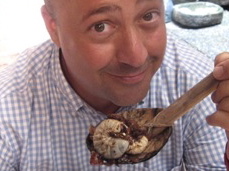
reference-image, l
(article, Andrew Zimmern)
The marriage of food and fire is as much about the experience as it is about the finished product. Sometimes the twist is in the fire, with an unusual type of fuel. Sometimes it's in the food, with a rare item or ingredient making a meal stand out. Often, it's a combination of the two — and adding an unfamiliar location to the mix can ensure a night to remember. Here are a few grillables seared into my memory. [[block(sidebar). h1. Wordplay I love the various origin myths surrounding the word “barbecue." My favorite is the notion that the Europeans arrived in the Caribbean basin and saw whole animals — perhaps goats, feral pigs, or wild dog-sized rodents called aguti — turning on spits. They called the spits barbe à coeur, or "stick though the heart." Get it? Barbe à coeur, barbecue. ]] Pimento wood is what gives true jerk BBQ its unique flavor. The wood, berries, and leaves of the allspice tree are available these days for the first time in the States, allowing us to recreate the ultimate island BBQ experience. I have had goat, guinea pigs, a guinea-pig relative called aguti, and the more familiar chicken and pork cooked over pimento wood. Aromatic with deep citrusy and smoky notes, the wood makes all the difference in the world. In Cora, Venezuela, there are grilled-goat merchants who will part with hefty sandwiches doused liberally with hot chile vinegar on crisp rolls. There’s nothing better — unless, of course, you happen to have eaten at the Kamayan sa Palaisdaan, a restaurant in the mountains of Quezon province in the Philippines, where every table floats on its own bamboo raft in an interconnected series of rivulets and ponds. Here they grill local fish brushed with ginger and sweet soy. The fish resemble tilapia, and they’re cooked over smoldering fires of coconut-shell coals. [%image andrew size=medium float=right credit="Photo courtesy Andrew Zimmern" caption="The author eating grubs in the Philippines."] In Morocco, the food-and-fire connection is strong. In the evening, carts roll into the central square at the Djemma al Fna, the famous market in Marrakesh. Soon the square becomes a vast and portable collection of grilled snacks. Grilled sheep’s heads. Liver kebabs. Grilled flounder. Tagines of every type. And mint tea at every turn. The star of the show here is the mashwi, whole lamb slow-roasted in wood-burning pits. The mashwi vendors build large fires in deep cylindrical clay pots buried in the ground (think of tandoori ovens the size of Volkswagens). The lambs are strapped to logs, lowered into the ovens, and left for 12 hours. Then they're pulled out, portioned, and sold on torn pieces of stiff thick paper used as a plate, sprinkled with cumin salt and paired with flat discs of soft bread. Heaven. So what have I gained over my years of sampling grilled goods, besides a full stomach? That the space between the fire and the food is always best left occupied by the ingenuity of whomever has the most burn marks. p(bio). Andrew Zimmern’s new primetime series, “Bizarre Food with Andrew Zimmern!”, airs weekly on the Travel Channel. He is also an associate editor and restaurant critic for Minneapolis-St. Paul Magazine.

reference-image, l

andrew, l